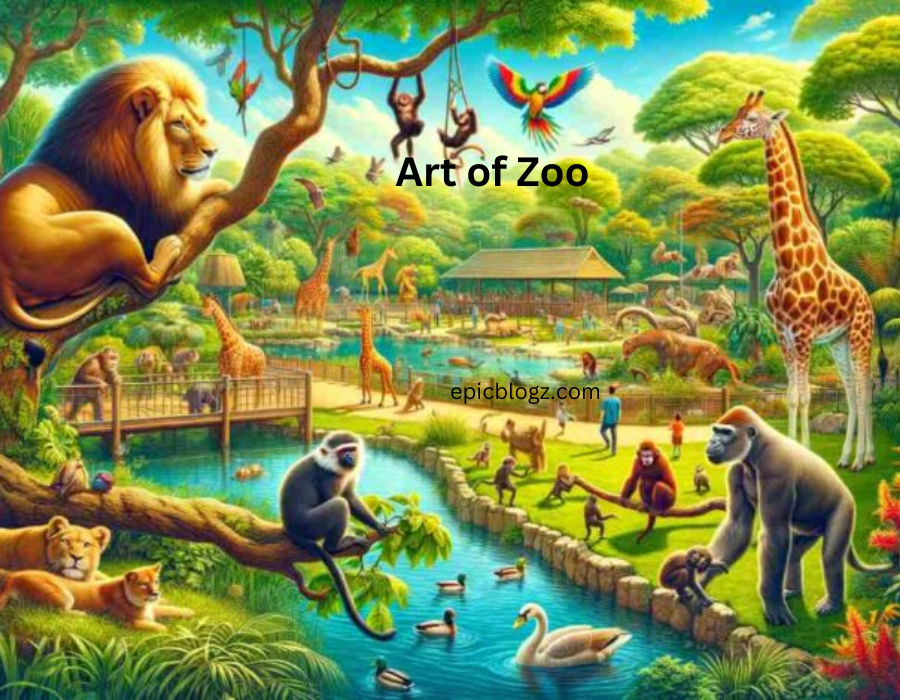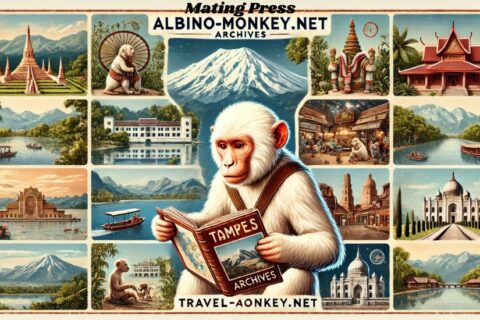Introduction
When we think of zoos, our minds often drift to the excitement of seeing wild animals up close, feeling the heartbeat of nature in a controlled environment. But zoos are more than just spaces to observe animals; they have evolved into platforms for inspiring creativity. The art of zoo—an emerging trend of celebrating wildlife through artistic expression—offers a window into the beauty of nature, the diversity of animal species, and the deep bond humans share with the wild.
This creative avenue merges conservation efforts, environmental awareness, and artistic brilliance to elevate how we view both animals and their habitats. Art and wildlife have long been interconnected, but the role of the zoo in this artistic journey brings a fresh perspective. Zoos today act as a bridge between nature and humanity, becoming hubs where artistic inspiration is cultivated, where every creature has a story to tell, and where humans can reconnect with their wild roots.
Artistic Expression of Wildlife: A Timeless Connection
Throughout history, animals have played an essential role in human culture. From the ancient cave paintings of Lascaux in France to the intricate hieroglyphs of Egypt, wildlife has always inspired artists to create masterpieces that speak to their reverence for nature. Today, the artistic expression of wildlife has expanded beyond these early depictions, encompassing a wide range of mediums—from painting and sculpture to photography and digital art.
Zoos, which house animals from around the world, offer a unique opportunity for artists to study creatures in detail and capture their essence. Unlike wildlife documentaries or safaris, zoos provide close-up and sometimes intimate interactions that can deeply influence an artist’s perception of an animal. The nuances of movement, the texture of fur, and the way animals interact with their environment become the focal points of creative works, helping artists portray the natural world in new and imaginative ways.
By serving as a sanctuary for artists, zoos foster creativity that celebrates biodiversity while promoting conservation. The art of the zoo is more than just an artistic endeavor; it’s a celebration of life itself, a way to reconnect with the natural world that humans sometimes take for granted.
The Role of Zoos in Inspiring Creativity
Zoos are not just centers for animal care and conservation; they are also places that spark artistic inspiration. By offering visitors the chance to closely observe exotic animals, zoos allow artists to capture the majesty of wildlife in ways that inspire awe and respect for the natural world. Many zoos have now embraced this aspect of their identity, encouraging both professional and amateur artists to use their spaces as creative canvases.
Through art exhibitions, live painting sessions, and even art competitions, zoos are actively nurturing the link between art and conservation. These programs don’t just serve the artistic community but also act as a means of educating the public. Wildlife art at zoos can inspire environmental consciousness, drawing attention to endangered species and the importance of preserving natural habitats. This artistic expression becomes a form of advocacy, where artists use their talents to highlight the fragility and beauty of the natural world.
The Intersection of Conservation and Art
One of the most significant impacts of wildlife art in zoos is its contribution to conservation efforts. Conservation and art have a symbiotic relationship, with each supporting and enhancing the other. Artists often use their works to raise awareness about endangered species, habitat destruction, and environmental issues that threaten wildlife populations.
Many zoos have recognized the power of art to promote their conservation goals. Collaborating with artists, they organize exhibitions and auctions where wildlife-themed artworks are sold to raise funds for conservation projects. In some cases, zoos invite resident artists to document animal behaviors or create large-scale murals that reflect the biodiversity of the species in their care.
This fusion of art and conservation creates a compelling narrative that captures the imagination of zoo visitors. By viewing art that celebrates wildlife, people become more connected to the animals and more committed to supporting conservation initiatives. Whether through photography, painting, or sculpture, wildlife art in zoos serves as a reminder of the responsibility humans have to protect the creatures with whom we share the planet.
Why Wildlife Art Resonates with the Public
There is something innately captivating about wildlife art. Animals have a universal appeal, and their presence in artistic works often evokes powerful emotions. Art that features animals allows viewers to experience the majesty of wildlife up close, giving them a sense of wonder and appreciation for nature’s diversity.
For many, wildlife art is not just a form of decoration but a statement of their personal connection to nature. Owning a painting of a tiger, for example, may symbolize strength, courage, or beauty. Similarly, sculptures of birds in flight may evoke feelings of freedom and peace. These artistic interpretations of animals have a deep emotional resonance, allowing individuals to bring the wild into their homes and lives.
In the context of zoos, wildlife art also serves as a medium for storytelling. Each piece tells the story of a particular animal or species, whether it be through the artist’s interpretation of the animal’s behavior, the vibrant colors of its habitat, or the movement captured in a sculpture. For zoo visitors, seeing these artistic representations adds another layer to their experience, connecting them not only to the animals themselves but to the broader narrative of wildlife conservation.
Zoos as Art Galleries: A Growing Trend
More and more zoos are recognizing the importance of art in their mission to educate and inspire the public. Several zoos have begun to feature dedicated art galleries where wildlife-themed pieces are on display. These galleries often feature rotating exhibits, showcasing the works of local artists alongside internationally renowned wildlife artists.
By blending art with education, zoos can offer visitors a unique experience. Viewing animals in their enclosures is one thing, but seeing an artist’s interpretation of those same animals allows for a deeper connection and understanding. Some zoos have even taken the next step, creating live art installations where artists work on pieces in real-time, allowing visitors to see the creative process unfold.
These art spaces within zoos serve as both cultural and educational hubs. They engage the public in conversations about the natural world while providing a platform for artists to express their vision of wildlife. The success of such initiatives speaks to the public’s growing interest in the intersection of art and nature.
The Evolution of Wildlife Art Techniques
Wildlife art has evolved over time, much like the animals it portrays. Traditional methods such as painting and sculpture remain popular, but newer techniques have emerged, pushing the boundaries of what wildlife art can be. Photorealistic paintings, for instance, offer incredibly detailed depictions of animals that can be so lifelike that they feel like photographs. Conversely, abstract interpretations challenge viewers to see animals in a new light, often focusing on movement, color, or emotion rather than strict accuracy.
Photography, too, has become a major component of wildlife art. Modern technology allows photographers to capture stunning, high-resolution images of animals, freezing moments of grace, power, and vulnerability in time. Digital art, using tools like tablets and graphic design software, is yet another frontier in wildlife expression. It offers endless possibilities for creativity, blending the real and imagined to showcase the beauty of animals in new and fantastical ways.
What ties all these techniques together is the shared goal of celebrating wildlife. Whether through brushstrokes or pixels, each artist contributes to a global conversation about the importance of animals in our world.
Engaging the Next Generation: Wildlife Art for Children
Zoos play an essential role in sparking a love of nature and art in children. Many zoos offer programs designed specifically for young visitors, encouraging them to explore their artistic talents while learning about animals. Art workshops, wildlife drawing classes, and interactive exhibits are just a few ways zoos engage with children.
These programs teach children about the importance of conservation while fostering creativity. By learning to draw or paint their favorite animals, children gain a deeper appreciation for wildlife and the environment. This hands-on approach not only enhances their artistic skills but also nurtures a lifelong connection to the natural world.
Zoos that invest in art-based programs for children are helping to cultivate the next generation of conservationists and wildlife advocates. By making art accessible and fun, they inspire young minds to think critically about the world around them and how they can help protect it.
The Future of Wildlife Art in Zoos
The future of wildlife art in zoos looks promising. As more people become aware of environmental issues and the importance of conservation, the demand for wildlife art is expected to grow. Zoos will likely continue to evolve as artistic spaces, integrating art with conservation efforts to create immersive experiences for visitors.
The integration of technology into wildlife art is another exciting possibility. Virtual reality and augmented reality are already being explored by some zoos, offering visitors the chance to experience animals in new and interactive ways. Imagine walking through a virtual jungle, where life-sized, three-dimensional animals move around you. These kinds of experiences are on the horizon, and they promise to make wildlife art more engaging and accessible than ever before.
At its core, the art of the zoo is about celebrating the beauty and diversity of wildlife while promoting conservation. It is a reminder of the deep connection between humans and nature, and the role that art can play in protecting the world we share with animals.
Conclusion
The Art of Zoo represents a captivating fusion of creativity and wildlife, offering a unique platform to celebrate and understand the beauty of nature. Through various artistic expressions—be it photography, sculpture, or interactive installations—this concept not only enhances the visitor experience but also fosters a deeper appreciation for animal life and conservation efforts. By engaging with the art found within zoo environments, we can inspire a greater awareness of biodiversity and the importance of protecting our planet’s inhabitants. Ultimately, the Art of Zoo serves as a reminder that creativity can play a vital role in promoting empathy and understanding toward the natural world, making every visit an enriching journey for art lovers and animal enthusiasts alike.
ALSO RAED: Https://mobilehomeexteriors.com: Transform Your Mobile Home
FAQs
What is the art of zoo-inspired creativity?
The art of zoo-inspired creativity refers to the artistic expression inspired by animals observed in zoos. It includes painting, sculpture, photography, and more, with a focus on celebrating wildlife and promoting conservation.
How do zoos support wildlife artists?
Zoos offer a unique environment for artists to study animals up close, provide exhibition spaces for wildlife-themed art, and collaborate with artists to raise awareness and funds for conservation efforts.
Why is wildlife art important for conservation?
Wildlife art raises awareness about endangered species and environmental issues. By showcasing the beauty of animals, artists inspire viewers to support conservation efforts and protect natural habitats.
How do children benefit from wildlife art programs in zoos?
Wildlife art programs in zoos teach children about animals and conservation while fostering creativity. These programs inspire a love for nature and encourage the next generation to become wildlife advocates.
What are the latest trends in wildlife art?
Photorealistic painting, digital art, and photography are popular trends in wildlife art. Virtual reality and augmented reality are also being explored to create interactive wildlife experiences.
How can I support wildlife art and conservation efforts?
You can support wildlife art by attending zoo exhibitions, purchasing wildlife-themed art, and donating to conservation projects. Many zoos collaborate with artists to raise funds for protecting endangered species.







